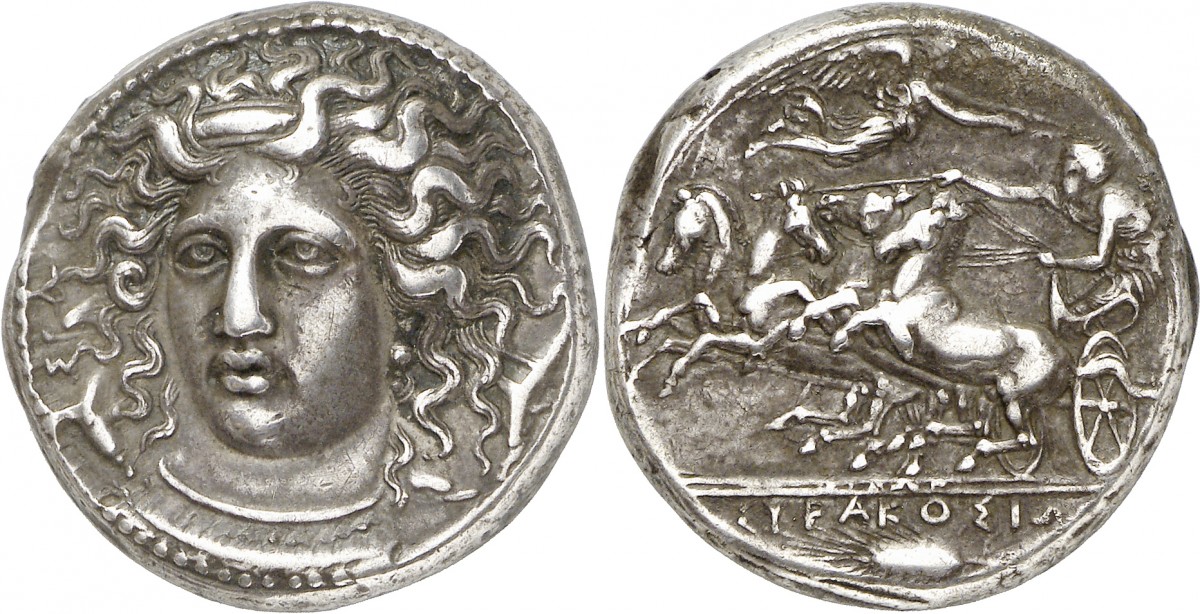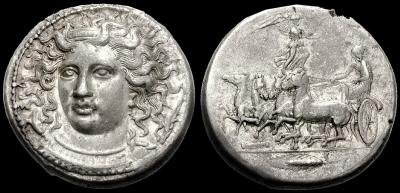

MONNAIE GRECQUE
Tetradrachme d'argent de Sicile, Syracuse, 406 AvJc, 17.03gr, 25 mm, seulement cinq exemplaires connus. Signé deux fois de KIMON. Estimation 200 000 euros. De toute rareté.
Description
Sicile. Syracuse.Sous le règne du roi Dionysios I (c.405-367 Av.JC.) 405 AvJc . Tétradrachme , 17,03g . 25mm, Avers: Trois - quart face à la tête d'Aréthuse , signature de l'artiste ΚΙΜΩΝ sur le bandeau . Tête d'Aréthuse légèrement incliné vers la gauche, portant un Ampyx dans ses cheveux sur laquelle est la signature K [ IMΩ ] N est visible. Bordure de ponitillés. Ci-dessus, [ ΑΡΕΘΟΣΑ ] . Revers : quadrige à gauche , Nike volant juste au-dessus , le pilote couronnement , signature de l'artiste ΚΙΜΩΝ en ligne à l'exergue . En exergue , épis de blé et ΣΥΡΑΚΟΣΙΩΝ . Tudeer 80 . Jameson Coll . 1835. SNG Oxford 2004. Nanteuil Coll . 358.Superbe .
La
Tête d'Arethuse de Kimon est l'une des plus célèbres créations des visages de l'antiquité, rivalisant même avec l'Arethuse du décadrachme d'Euainetos (Evainète). Comme ce dernier, l' Arethuse du visage de Kimon a été rapidement adoptée par d'autres monnaies en Grèce et à l'étranger , ainsi que par des peintres de vases et des ouvriers de la métallurgie . L'attrait de la conception , même dans les régions éloignées comme la Lycie et la Cilicie montre qu'elle était appréciée. Le point n'est pas dans l'audace de montrer une tête de 3/4 face à l'observateur - cette idée était dans l'air depuis de nombreuses années , surtout parmi les peintres de vases . L'attraction révolutionnaire est dans l'expression qui ouvre une voix à une nouvelle philosophie de vie. Dans l'Antiquité et aux débuts archaïques , les visages ont été utilisés par les peintres de vases et sculpteurs pour caractériser des mourants et des morts guerriers , ainsi que des monstres tels que les gorgones . Ensuite , les visages étaient utilisés pour montrer quelque chose d'effrayant . Les visages qu'on voulait montrer en perspective, sont représentés de trois-quarts , et ne sont venus à la mode qu'à l'époque classique au début , c . 470 av . D'après les scénarios qu'ils ont été utilisés , ils sont pensés pour caractériser un processus de raisonnement , ou une perception sophistiquée comme l'écoute de musique. L' Arethusa de 3/4 face de Kimon , cependant, est totalement différente. La nymphe n'agit pas comme un être mythologique , l'exécution de son rôle dans le mythe est celui dit du dieu-fleuve Alphée . Elle n'agit pas du tout, mais simplement en se présentant à l'observateur, elle s'amuse plutôt que d'exécuter un rôle. Cette conception apparaît comme le premier précurseur d'une nouvelle vision des dieux grecs . Dans l'art du cinquième siècle , les dieux agissaient en êtres , engagé dans les affaires humaines . Dans l'art du 4ème siècle , les dieux restaient entre eux , profitant de leur sphère divine , et non plus face à de bagatelles humains. D'une part , cette évolution est conforme à la pensée grecque ancienne , exprimée dès Homère qui parle des «dieux faciles à vivre " . D'autre part, cette vision des dieux est totalement nouvelle et révolutionnaire . Le vieux doute qui ronge était de savoir si les divinités contrôlent réellement les affaires humaines , établissant ainsi des normes morales et d'équilibre pour les nombreuses grandes injustices de la vie humaine , a fait son chemin dans la philosophie grecque au cours des cinquième et quatrième siècles , ce qui conduit à de nouvelles conceptions de l'art grec . Donc l'Arethusa de face de Kimon est susceptible d'être le premier , et le plus influent , le prédécesseur de chefs-d'œuvre de l'art du quatrième siècle comme Aphrodite de Cnide de Praxitèle et l'Hermès d'Olympie .
Description:
Sicily. Syracuse. under the reign of Dionysios I (c.405-367 B.C.), 405 BC. Tetradrachm, 17,03g., 25mm (h). Obv: Three-quarter facing head of Arethusa, artist's signature ΚΙΜΩΝ. Head of Arethusa facing, inclined slightly to the left, wearing an ampyx in her hair upon which is the signature K[IMΩ]N visible. Dotted border. Above, [ΑΡΕΘΟΣΑ]. Rx: Racing quadriga left, Nike flying right above, crowning driver; artist's signature ΚΙΜΩΝ on exergual line. In exergue, wheat ear and ΣΥΡΑΚΟΣΙΩΝ. Tudeer 80. Jameson Coll. 1835. SNG Oxford 2004. Nanteuil Coll. 358. EF.
Kimon’s facing Arethusa is one of the most famous head designs of antiquity, rivaling even the Arethusa of Euainetos’ decadrachm. Like the latter, Kimon’s facing Arethusa was quickly adopted by other mints at home and abroad, as well as by vase painters and metal workers. The design’s attraction even in remote areas such as Lycia and Cilicia shows it got to the heart. The point is not in the boldness to show a head 3/4 facing to the observer – this idea was in the wind for many years, though mainly among vase-painters. The revolutionary attraction is in the expression that gives a voice to a new philosophy of life. In archaic and early classical times, heads looking to front were used by both vase painters and sculptors for characterizing dying and dead warriors, as well as monsters like the Gorgons. Then, facing heads were something scary. Heads about to turn around, thus seen in three-quarter perspective,only came into fashion in early classical times, c. 470 BC. Judging from the scenarios they were used in, they are thought to characterize a process of reasoning, or a sophisticated perception like listening to music. Kimon’s facing Arethusa, however, is totally different. The nymph is not acting as a mythological being, executing her role in the myth told about her and the river god Alpheios. She is not acting at all, but merely presenting herself to the observer, thereby enjoying herself rather than executing a role. This design appears to be the earliest forerunner of a new view of the Greek gods. In fifth century art, the gods were acting beings, engaged in human affairs. In fourth century art, the gods kept to themselves, enjoying their divine sphere, and no longer dealing with human trifles. On the one hand, this development accords with old Greek thinking, expressed as early as Homer who spoke of the “easy-living gods”. On the other, this view of the gods is totally new, and revolutionary. The old gnawing doubt as to whether deities were really controlling human affairs, thereby setting moral standards and balancing out the many great injustices of human life, forced its way into Greek philosophy during the fifth and fourth centuries, thus leading to new designs in Greek art. So Kimon’s facing Arethusa is likely to be the first, and most influential, predecessor of masterpieces of fourth century art like Praxiteles’ Cnidian Aphrodite and Olympian Hermes.
 |
 |
L'exemplaire ci-dessus est assez proche de celui de la vente de NEW YORK Auction XXX du 1/9/2013 ci-dessous.

Description
ANCIENT COINS. GREEK. Sicily, Syracuse, Dionysios I (c.405-367 B.C.), Silver Tetradrachm, 17.15g, 12h. Signed on both the obverse and reverse by the artist Kimon, struck c.405-400 B.C. Head of Arethusa facing, inclined slightly to the left, wearing an ampyx in her hair upon which is the signature K[IMΩ]N (partially visible), and wearing an earring and a necklace, her flowing in long curls and from it emerge four dolphins, Σ Ω on left, outside of the dotted border above can be seen small traces of APE Θ O Σ A at the edge of the flan. Rev. Σ YPAKO Σ IΩ[N] (in the exergue), charioteer, wearing a long chiton and holding a kentron and the reins, driving a fast quadriga left, Nike flies above to right to crown the charioteer, the signature KIMΩN on the exergual line, an ear of barley in the exergue (Tudeer 80c (V29/R53) (this coin); Jameson 822 (this coin); Rizzo, pl. XLVIII, 11 (this obverse die), 10 (this reverse die); Boehringer, ‘Rekonstruktion des Schatzfundes von Ognina 1923’, SNR 57, 1978, pl. 37, 297 (these dies); H. Cahn, ‘Arethusa Soteira’, in Essays Carson-Jenkins, 1b (these dies); de Luynes 1226 (these dies); Boston 417 (these dies); Kraay – Hirmer, pl. 45, 123 (this obverse die), pl. 44, 122 (this reverse die)). Struck from dies of the greatest beauty engraved by a celebrated master artist of the late 5th Century B.C. Of the highest classical beauty, with a very attractive cabinet tone, very fine to good very fine. Extremely rare and one of the most famous of all ancient Greek coins. This coin published: ‘Die Tetradrachmenprägung von Syrakus in der Periode der signierenden Künstler’, L. Tudeer (ZfN, Berlin, 1913), p. 57, 8 0c. ‘Syracuse, ses monnaies d’argent et d’or au point de vue artistique’, Comte A. Duchastel (London, 1898), 89. ‘Collection R. Jameson, Monnaies Grècques Antiques’ (Paris, 1913-1932), 822, illustrated on pl. XLI. ‘Wealth of the Ancient World’ (Kimbell Art Museum, Fort Worth, 1983), 82. Ex F.S. Benson Collection, Sotheby’s, 8 February 1909, lot 347 Ex R. Jameson Collection, 822 Ex S. Weintraub Collection Ex Nelson Bunker Hunt Collection, Sotheby’s, New York, 19 June 1990, lot 82 This sublime coin displays the very finest talent of the master artist Kimon and this pair of dies is without doubt one of his greatest achievements. The head of Arethusa, brought here to the obverse of the coin and set in stunning facing majesty, is both arresting and at the same time serene. Her eyes stare longingly out from the composition, providing the viewer with a genuine sense of the divine and other-worldly. Then, outside of this peaceful gaze, the viewer is overwhelmed by a surprising amount of activity. Her hair flows wildly out behind her and down towards her shoulders and, from this busy arrangement, we can see dolphins emerging into view. These creatures seem almost to be playfully moving to and fro between the locks of her hair. The reverse of the coin is full of animation and energy, with the quadriga viewed in three-quarter perspective. The horses are rearing and tossing their heads in the heat of the moment as they speed towards their point of victory. This issue is without doubt one of the most important of the late 5th Century B.C. $180,000
| Vente | Lot | Date | Estimation | Adjudication |
|---|---|---|---|---|
| Triton XI | 61 (« | ») | 8. janv. 2008 | * (connectez-vous) | * (connectez-vous) |
